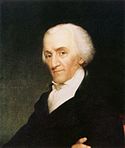Elbridge Gerry
 Wiceprezydent Elbridge Gerry | |
| Data i miejsce urodzenia | 17 lipca 1744 |
|---|---|
| Data i miejsce śmierci | 23 listopada 1814 |
| 5. wiceprezydent Stanów Zjednoczonych | |
| Okres | od 4 marca 1813 |
| Przynależność polityczna | |
| Druga dama | Ann Gerry |
| Poprzednik | |
| Następca | |
| Gubernator Massachusetts | |
| Okres | od 10 czerwca 1810 |
| Poprzednik | Christopher Gore |
| Następca | |
Elbridge Gerry (ur. 17 lipca 1744 w Marblehead, zm. 23 listopada 1814 w Waszyngtonie) – amerykański polityk, 5. wiceprezydent Stanów Zjednoczonych.
Był jednym z sygnatariuszy Deklaracji Niepodległości; członek Partii Demokratyczno-Republikańskiej. Pełnił urząd gubernatora Massachusetts w latach 1810–1812. Od 4 marca 1813 był wiceprezydentem USA (przy prezydencie Madisonie), zmarł w trakcie kadencji (także jego poprzednik George Clinton zmarł pełniąc funkcję wiceprezydenta).
Gerrymandering
Elbridge Gerry zasłynął jako prekursor manipulacji kształtem okręgów wyborczych. Będąc gubernatorem Massachusetts dokonał takiego podziału okręgu, że federalistów skupił w jednym jednomandatowym okręgu. Wyborcy popierający Partię Demokratyczno-Republikańską zostali rozdzieleni do pozostałych okręgów, dzięki czemu jego partia skorzystała z tego zabiegu. Znany malarz Gilbert Charles Stuart widząc kolorową mapkę z granicami okręgów wyborczych powiedział redaktorowi dziennika Columbian Centinel Benjaminowi Russelowi, że przypominają mu one kształtem salamandrę. Russel odpowiedział: raczej Gerrymandrę. Do dnia dzisiejszego określeniem gerrymandering nazywa się takie manipulowanie granicami okręgów wyborczych, które pomaga w uzyskaniu korzyści politycznych.
Linki zewnętrzne
- Biografia w Biographical Directory of the United States Congress (ang.)
- Biografia Senat Stanów Zjednoczonych (ang.)
- Biografia National Park Service (ang.)
Media użyte na tej stronie
Elbridge Gerry (1744–1814), American statesman
Logo of the United States White House, especially in conjunction with offices like the Chief of Staff and Press Secretary.
This is a high-resolution image of the United States Declaration of Independence (article - text). This image is a version of the 1823 William Stone facsimile — Stone may well have used a wet pressing process (that removed ink from the original document onto a contact sheet for the purpose of making the engraving).
Seal of the Vice President of the United States. The blazon is defined in Executive Order 11884 as:
The design is the same as the Seal of the President of the United States, except that there is no ring of stars, the clouds are gray (instead of proper), the stars are gray (instead of argent), the scroll is gray (instead of white), the arrows are gray (instead of proper), and the background colors and inscription (obviously) differ.The Coat of Arms of the Vice President of the United States shall be of the following design:
SHIELD: Paleways of thirteen pieces argent and gules, a chief azure; upon the breast of an American eagle displayed holding in his dexter talon an olive branch proper and in his sinister a bundle of thirteen arrows gray, and in his beak a gray scroll inscribed "E PLURIBUS UNUM" sable.
CREST: Behind and above the eagle a radiating glory or, on which appears an arc of thirteen cloud puffs gray, and a constellation of thirteen mullets gray.
The Seal of the Vice President of the United States shall consist of the Coat of Arms encircled by the words "Vice President of the United States."











